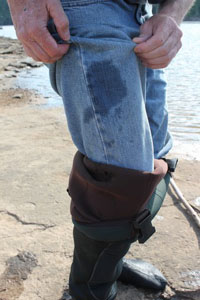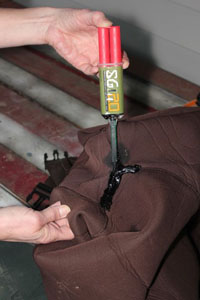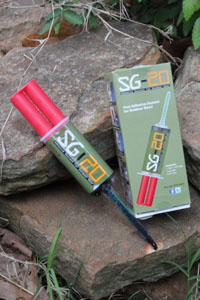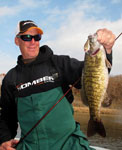 Leaking waders
Leaking waders |
It started slowly on my last trout fishing trip. My little leak has turned into a raging water spout. I don't know why, but sooner or later every pair of waders I own leak and need to be fixed.
Staying dry and having on the right pair of waders goes a long ways when you are trout fishing. Renowned tailwaters below dams can range from 35 degrees to 50 degrees. It's not the place you want to be fishing wearing leaky waders.
Depending on the conditions, anglers can select from chest, waist-high or hip waders. Chest waders are by far the most popular with anglers fishing for trout. They allow the fly fishermen and spinning tackle anglers the ability to wade deeper pools without fearing getting wet, however, they are more expensive and warm during the summer months.
What really makes a difference when it comes to waders for trout fishing is what materials manufactures use to make them. There's no one single pair of waders perfect for every condition or season. Popular materials consist of neoprene, canvas, rubber or breathable material like GORE-TEX.

Applying the SG-20 adhesive sealant |

SG-20 adhesive sealant for outdoor gear |
Neoprene waders are by far the most popular material being used to make waders. Depending on the brand and manufacture thickness can range from 3.5- to 5-millimeters. The neoprene used is similar to the material used to make wetsuits out of and can be repaired easily.
Canvas and rubber waders have several of the same characters along with being the most affordable. Canvas of course is more durable, but both have the same stiff, heavy and less comfortable feel. Finding a leak and patching the rubber waders can be done without difficulty.
Breathable waders constructed from materials like GORE-TEX are lightweight and extremely comfortable to wear. The wicking technology in breathable waders keep the anglers dry as it wicks away sweat. Fewer anglers own breathable waders due to the cost, but they can be repaired if they begin to leak.
Leaking waders can be fixed. The first thing you have to find is the leak. With neoprene waders put on a pair of blue jeans and wear them for a short period take them off to see where the high wet spot is located indicating the spot it's leaking.
Other techniques for finding leaks include turning the waders inside out and take them into a dark room while shinning a flashlight inside and look for areas of light shining through, spraying rubbing alcohol on the inside of the waders which will make dark spots indicating the leak and trapping air inside the waders and place underwater looking for bubbles.
When it comes to wader repair most adhesives require at least a full 24-hour dry and set time so an angler has to wait before going out fishing. The new SG-20 by Vettec, Inc. (www.SG-20.com) only requires one minute to set and one hour to dry making it the fastest repair adhesive for waders available. It's ideal for in the field repair so you don't have to stop for a short time before going back to fishing.
SG-20 is a two-part poly-urethane adhesive material able to adhere neoprene, poly-urethane or canvas. It renowned for being flexible, but yet durable lasting five or more years. The watertight seal created by SG-20 will not only keep you dry, but also dirt and debris from entering.
Helpful hints when using SG-20:
*SG-20 will set in the mix tip if not continually being dispensed.
*Have everything ready before dispensing SG-20.
*To store unused SG-20 keep the used tip attached to the cartridge then remove and attach new tip for the next repair.
*When the SG-20 is tacky to the touch it's still drying and should be allowed to dry to achieve the best results.
Waders are worth their weight in gold when they don't have leaks in them. They allow trout anglers the ability to be mobile and change locations when the fish stop biting, in addition to keeping them comfortable letting them stay out fishing longer.
If you do have holes in your waders they can be fixed. Just find where the leak is located and use a high quality adhesive like SG-20 to adhere the material together closing up the leak. Fixing your waders will not only keep you dry, but also save you money from having to purchase new ones.
 Brad
Wiegmann just wants to fish, but his wife told him to get a job so he works as a freelance outdoor writer/photographer when not fishing. He has written for magazines, website and anyone else that will pay him cold hard cash. His award winning website blows away wannabes that re-post news feeds or non-original articles. When not posting links to his content you can probably find him with his camera taking photos of fish, anglers, lures, fish with anglers, anglers with fish or fish with lures hanging out of the mouth. Did you know he loves to fish? Seriously, if it has fins or hooks, you can count on him to write, photograph or market it. You can contact him at (479)756-5279, at bwiegmann@cox.net or
visit his website at www.bradwiegmann.com for
more information.
Brad
Wiegmann just wants to fish, but his wife told him to get a job so he works as a freelance outdoor writer/photographer when not fishing. He has written for magazines, website and anyone else that will pay him cold hard cash. His award winning website blows away wannabes that re-post news feeds or non-original articles. When not posting links to his content you can probably find him with his camera taking photos of fish, anglers, lures, fish with anglers, anglers with fish or fish with lures hanging out of the mouth. Did you know he loves to fish? Seriously, if it has fins or hooks, you can count on him to write, photograph or market it. You can contact him at (479)756-5279, at bwiegmann@cox.net or
visit his website at www.bradwiegmann.com for
more information.

